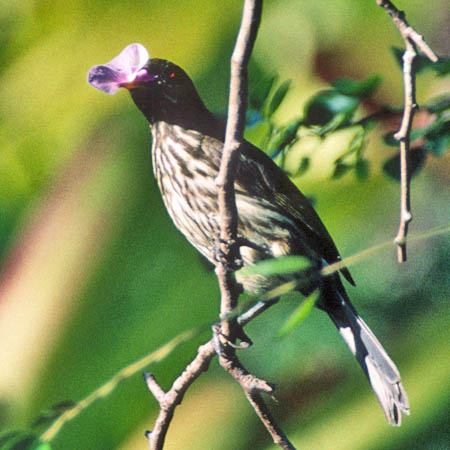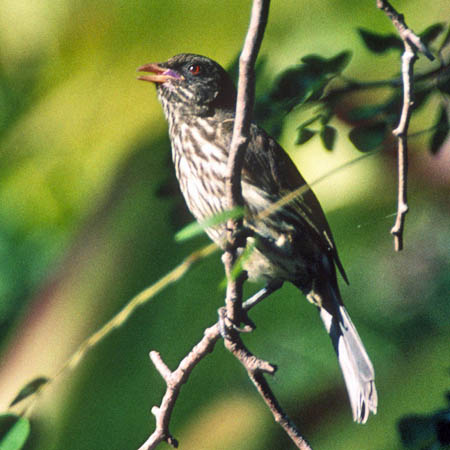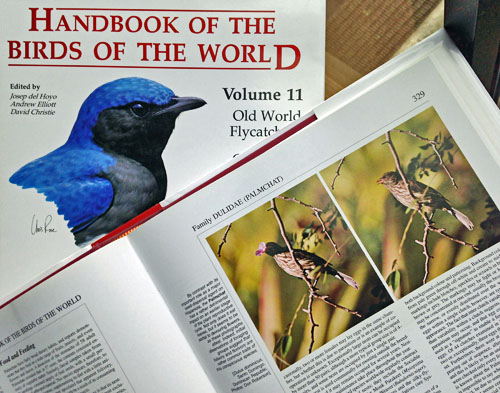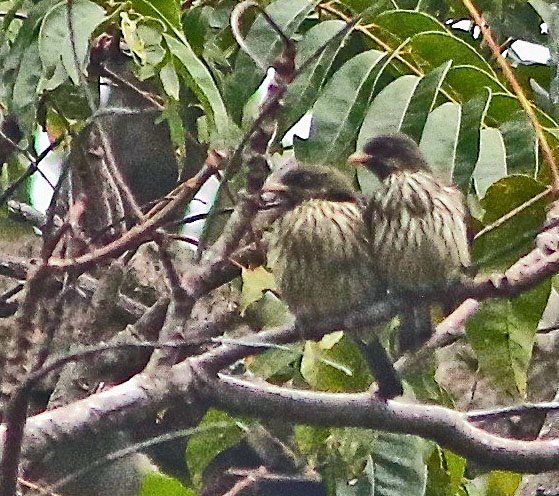
a web page by Don Roberson |
PALMCHAT Dulidae |
||
|
||
 Palmchat is endemic to the island of Hispaniola in the Caribbean where it is common. In fact, it was the very first bird we saw in the Dominican Republic from our hotel in the capital city of Santo Domingo. Palmchat (all photos on this page) particularly favors Royal palms Roystonea. Gregarious gangs of Palmchat are frequent wherever the palms occur. It is a moderately odd bird in the field, looking most like a coarse-plumaged tanager or Old World oriole, but differing in being rather vocal (but just gurgles and "cheeps") and in its gregarious behavior. Palmchat is endemic to the island of Hispaniola in the Caribbean where it is common. In fact, it was the very first bird we saw in the Dominican Republic from our hotel in the capital city of Santo Domingo. Palmchat (all photos on this page) particularly favors Royal palms Roystonea. Gregarious gangs of Palmchat are frequent wherever the palms occur. It is a moderately odd bird in the field, looking most like a coarse-plumaged tanager or Old World oriole, but differing in being rather vocal (but just gurgles and "cheeps") and in its gregarious behavior. Traditional taxonomists generally place Palmchat in its own family because of peculiarities that suggest it is not closely related to any of the major passerine groups. Avery (1951), in a study of plumage, feeding and nesting habits, skeleton, digestive track, and certain muscles, found it closely related to silky-flycatchers and waxwings, and put them all in the Waxwing family Bombycillidae. Sibley & Monroe (1990) agreed on the relationships, but put Palmchat in a tribe [Dulinae] of the Bombycillidae. More recent taxonomists, using molecular evidence, have revived the Dulidae to its long-accustomed status as a full Family with a long evolutionary track of its own. Fossils in Hispaniola caves date back to perhaps 50,000 years (Temple 2005). Although flocks of Palmchat move through the treetops in open country, it is not well-studied. It tends to remain in the canopy, and does not feed on the ground (Temple 2005). Palmchats eat fruit and berries, but at the botanical gardens in Santo Domingo this particular bird (left) was pulling off and eating whole flowers!
|
||
 |
||
| Although Palmchats do consume some small invertebrates, it is generally considered to be a vegetarian generalist. They often forage on the berries of the royal palms, in which they build nests that are used for communal roosts outside the breeding season. Temple (2005) noted that these habits help to disperse seeds across Hispaniola, but they also indulge in folivory (eating leaves) and florivory (eating flowers), and illustrated that comment with these two photos (below) that I took on my short 1999 visit to the Dominican Republic. | ||
|
||
By pure happenstance, the editors of Handbook of the Birds of the World used my slides -- which are posted just above -- on p. 329 of Vol. 10 (right). In those pre-digital days, only a few traveling birders took slide photos. Today, of course, "everyone" has a digital camera and there would be abundant competition for publication space! I just happened to have a bit of luck, given the time and place. And for me, very gratifying indeed [they also used by large portrait shot (near top of this page) on p. 327 of Vol. 10 of the Handbook as well! |
||
Groups colonially build huge, bulky stick nests, with individual nest-chambers of each pair, which are crudely lined with dried grass and strips of palm leaves. These nests shelter the young in breeding season, which can vary from February through August, depending on the location and how the rainy season varies from site to site. During a very short re-visit to the Dominican Republic in February 2017, pairs of Palmchat were huddled together in the canopy (left), near large nests, and may have been contemplating nesting in the near future. |
||
Photos: The photos of Palmchat Dulus dominicus were primarily taken in January 1999 in the Santo Domingo botanical gardens, Dominican Republic; the final photo of a pair was along Cachiote-Cienga Road, Dominican Republic, on 3 Feb 2017. All photos © Don Roberson; all rights reserved. Bibliographic note: There is no "family book" per se, but a good introduction to the family, with some nice photos, is in Temple (2005). Literature cited:
|


 Oddly enough, my original 1999 web page on Palmchat was the very first one that I created in this on-line project. It is now 2020 and I'm finally getting around to an updated version.
Oddly enough, my original 1999 web page on Palmchat was the very first one that I created in this on-line project. It is now 2020 and I'm finally getting around to an updated version. Palmchats are resident on Hispaniola, and do not undertake any known migrations. It seems a poor disperser, as though it occurs on nearshore islets, it is notably absent from those lying 10 km or more offshore (Temple 2005).
Palmchats are resident on Hispaniola, and do not undertake any known migrations. It seems a poor disperser, as though it occurs on nearshore islets, it is notably absent from those lying 10 km or more offshore (Temple 2005).